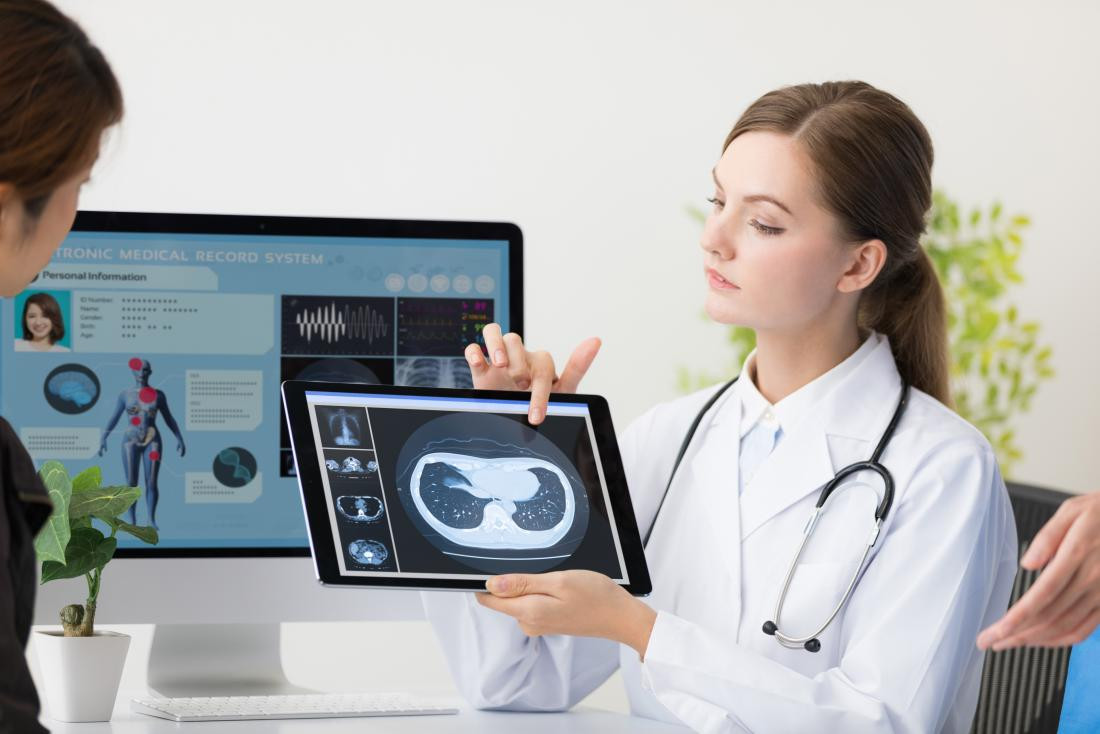When your doctor recommends Cat Imaging, or a CT scan, it’s natural to have questions and perhaps some concerns. Understanding the procedure, its benefits, and potential risks is crucial for making informed decisions about your health. This article will explore the risks associated with cat imaging, ensuring you have a clear picture of what to expect. Before undergoing a cat scan, your healthcare provider should thoroughly explain why the scan is necessary, discuss alternative diagnostic options, and outline both the advantages and disadvantages of proceeding with this imaging technique.
A cat imaging scan utilizes a small, focused dose of radiation to generate detailed images of the inside of your body. Many people worry about radiation exposure, but it’s important to understand the context.
 A doctor explaining a CT scan to a patient, highlighting the importance of understanding cat imaging risks and benefits for informed healthcare decisions.
A doctor explaining a CT scan to a patient, highlighting the importance of understanding cat imaging risks and benefits for informed healthcare decisions.
Even for individuals who have undergone multiple cat scans throughout their lives, the levels of radiation involved are not considered to be demonstrably harmful. The likelihood of developing cancer as a direct consequence of a cat imaging scan is estimated to be very low, less than 1 in 2,000.
To put this into perspective, the radiation exposure from a cat scan is roughly equivalent to the amount of natural background radiation a person would encounter over a period of several months to several years in their everyday environment.
Cat scans are only recommended when there is a clear and valid medical reason. These detailed images are invaluable for diagnosing and guiding the treatment of various medical conditions, some of which could be potentially serious if left undetected or untreated. Therefore, when a decision is made to perform a cat imaging scan, medical professionals carefully weigh the benefits of accurate diagnosis and timely treatment against any potential risks associated with radiation exposure. The goal is always to ensure that the advantages of the scan significantly outweigh any possible disadvantages.
While the radiation risk is low, potential problems from radiation exposure, though extremely unlikely, can include cancer and thyroid issues.
These risks are even less probable in adults and still remain unlikely in children. However, it’s recognized that children are generally more susceptible to the effects of radiation compared to adults. This does not automatically mean that health problems will arise in children who undergo cat scans. Nonetheless, it’s a standard practice to document any CT scans a child receives in their medical records for future reference and to track cumulative radiation exposure over their lifetime.
In numerous medical situations, a cat scan is uniquely capable of providing the necessary diagnostic information that other imaging techniques may not be able to offer. While alternatives like ultrasound or MRI scans might be suitable for certain conditions, for others, cat imaging remains the most effective or sometimes the only method to visualize the internal structures with the required clarity.
Cat Imaging and Pregnancy Considerations
It is critical for any woman who suspects she might be pregnant to inform her doctor before undergoing a cat scan. This precaution is necessary because there is a potential risk that the radiation exposure from the scan could be harmful to the developing fetus.
Referencing the American College of Radiography, the American Pregnancy Association (APA) emphasizes that “No single diagnostic x-ray has a radiation dose significant enough to cause adverse effects in a developing embryo or fetus.” This highlights that the radiation from a single scan is generally considered to be very low risk to a fetus.
However, despite the low risk from a single scan, the APA guidelines still recommend that cat scans should be avoided during pregnancy “Unless the benefits clearly outweigh the risk.” This cautious approach underscores the importance of carefully considering the necessity of a cat scan during pregnancy and exploring alternative imaging methods whenever possible.
Cat Scans and Breastfeeding Mothers
For mothers who are breastfeeding and require a cat scan with iodinated intravenous contrast dye, there is a specific recommendation to temporarily interrupt breastfeeding. The concern is that the contrast dye could potentially pass into breast milk and subsequently be ingested by the infant. To minimize any potential exposure of the infant to the contrast agent, it is generally advised to avoid breastfeeding for approximately 24 hours after receiving the contrast dye. This allows sufficient time for the contrast agent to be cleared from the mother’s system, reducing the likelihood of it being present in breast milk.
Claustrophobia and Cat Imaging Procedures
Patients who suffer from claustrophobia, a fear of enclosed spaces, should proactively inform their doctor or the radiographer prior to their cat scan appointment. Cat scan machines can sometimes feel confining to individuals with claustrophobia, potentially triggering anxiety.
 A doctor explaining a CT scan to a patient, highlighting the importance of understanding cat imaging risks and benefits for informed healthcare decisions.
A doctor explaining a CT scan to a patient, highlighting the importance of understanding cat imaging risks and benefits for informed healthcare decisions.
To manage claustrophobia and ensure the patient can undergo the necessary cat imaging procedure, medical staff can take specific measures. In some cases, the patient may be offered a sedative medication, either in the form of an injection or a tablet, to help them relax and reduce anxiety before the scan. Open cat scan machines are also available in some facilities, which can be less confining and more comfortable for claustrophobic patients. Communicating claustrophobia concerns in advance allows the medical team to make appropriate accommodations and ensure a more comfortable and less stressful experience during the cat imaging process.

